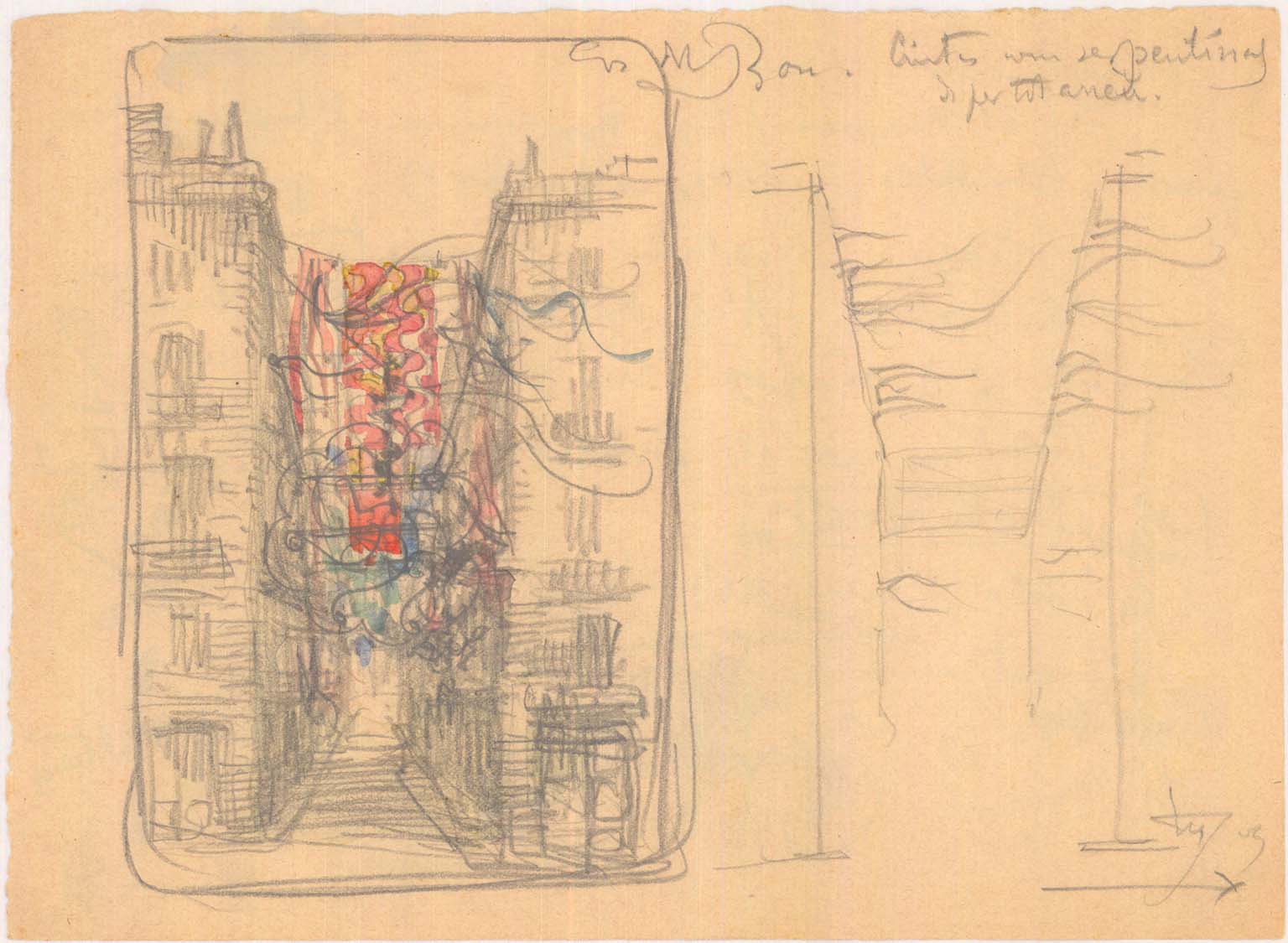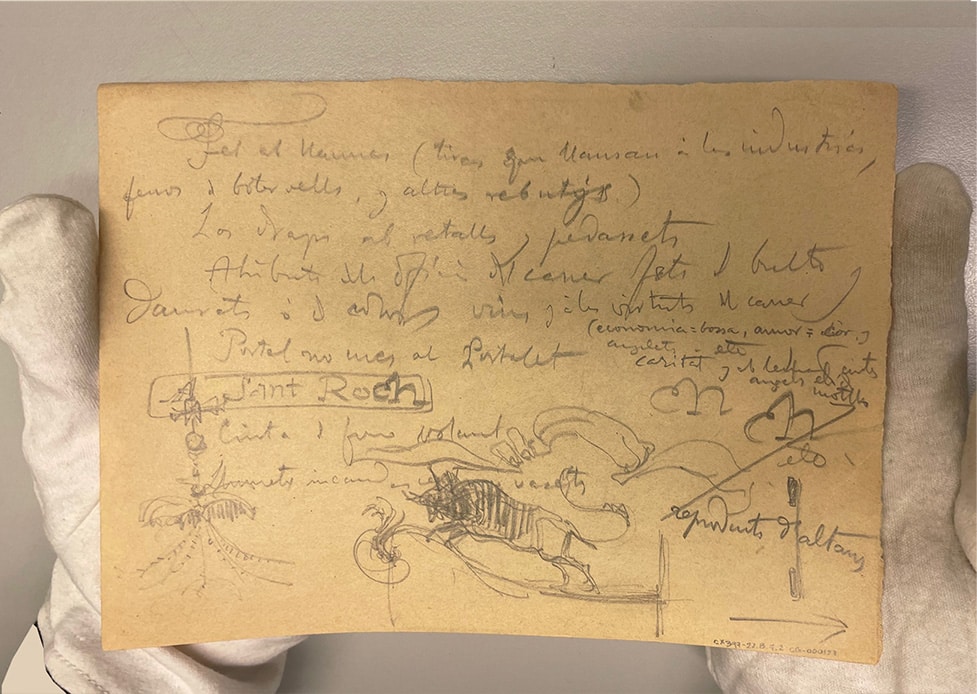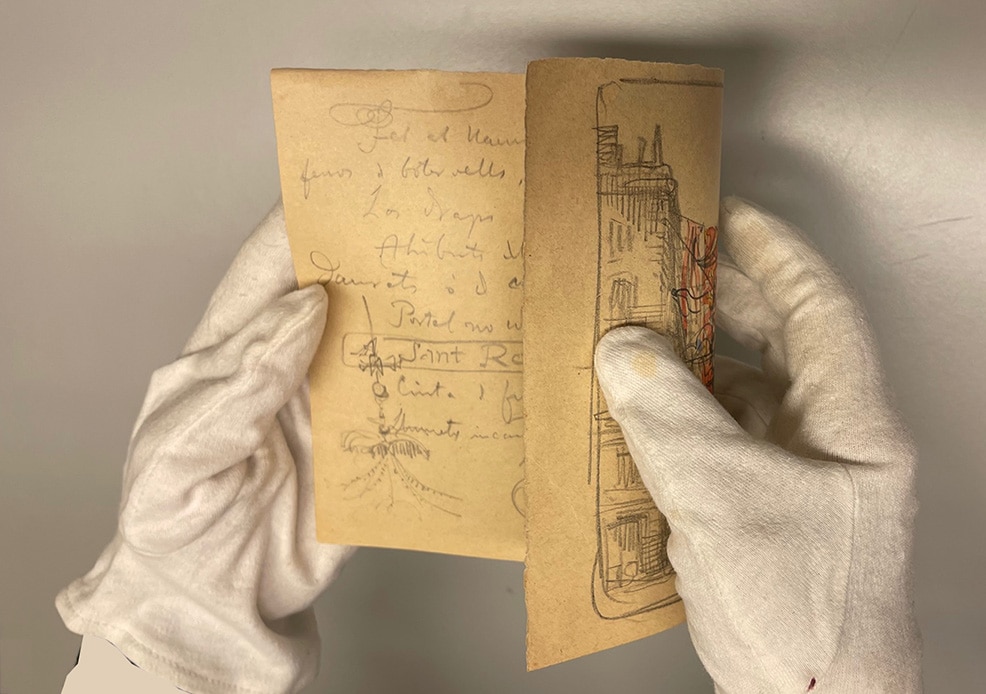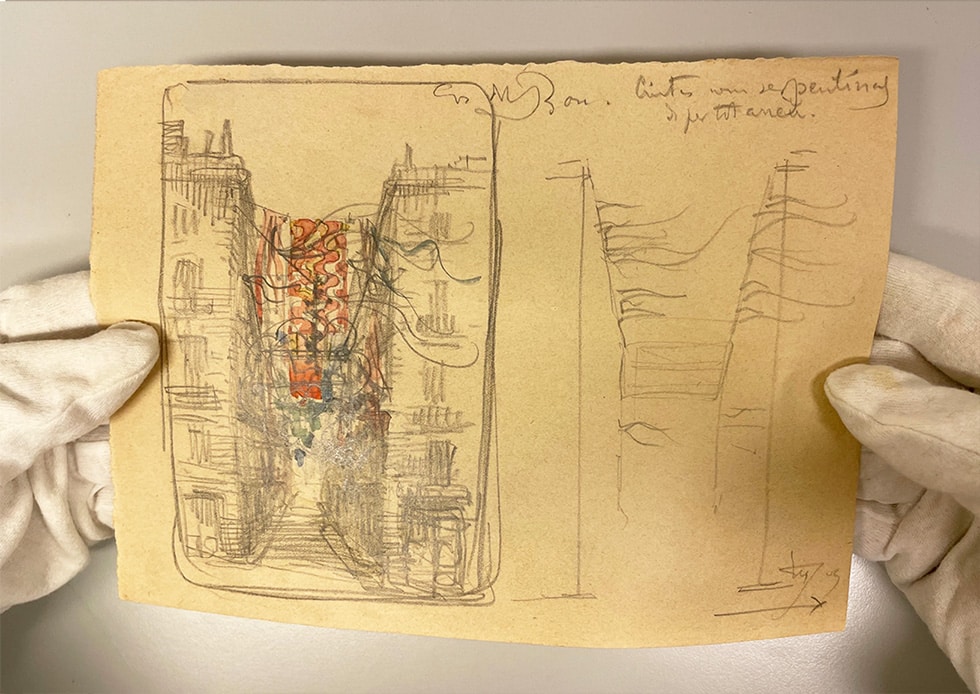Josep Maria Jujol: Ribbons with Streamers Everywhere
– Juan Mercadé Brulles, Jesús Esquinas-Dessy and Isabel Zaragoza

During the process of cataloguing drawings from the special collection of Josep Maria Jujol (1879-1949), housed in the graphic archive of the Barcelona School of Architecture (ETSAB UPC), our attention was drawn to a particular drawing, illustrating a festive urban sequence.[1] At first glance, it is a captivating object, simultaneously conveying the intention behind a design and, the visual representation of that concept, employing a series of graphically enticing resources. Subsequent research revealed a text, authored by the architect’s son Josep Maria Jujol Jr., that elucidates his father’s relationship with the drawing’s subject: the ‘Cós del Bou’ street, located in the heart of Tarragona, Spain, which undergoes a remarkable transformation during the San Roque festivities, becoming the focal point of lively, collaborative embellishment. Jujol leased an apartment on the street[2], and it was while witnessing the neighbours adorning the street with handcrafted paper fringes that he was prompted to seize a sheet of paper and design various prospective decorations.
The drawing, executed on thinly textured paper, characteristic of letter paper, features inscriptions on both its recto and verso surfaces in which Jujol constructs a sequential graphic narrative.[3] In one frame, he presents a perspective of the street, unveiling multiple layers of information. The base layer, executed in graphite, details the street’s residences, encompassing openings, signage, shutters, balconies, balustrades, finishing touches, cornices, chimneys, and other architectural elements. Another layer comprised of cords connecting these residences and uniting the inhabitants on both sides, serves as the canvas for the decorative embellishments. A further layer composes an assortment of differently dimensioned flags, each distinguished by varying watercolour palettes. Lastly, an abundance of undulating threads, some rendered in blue, introduces a sense of fluidity and movement. These layers of creativity converge to the point where recognizing the fundamental form of the street becomes increasingly challenging.
On the right-hand side of the drawing, a second sketch is inscribed with the phrase: ‘Cintes com serpentines per tot arreu’, in English translation, ‘ribbons as streamers everywhere’. This representation outlines the structural contours of the street’s buildings, with a deliberate emphasis on the many decorative streamers, integral to Jujol’s festive proposal, suspended from the rooftops. A directional arrow at the bottom of the drawing indicates a potential continuation of the narrative on the reverse side.

Handwritten inscriptions and symbols on the reverse side invite exploration featuring sketches and notes about to the ornamentation of the ‘San Roque’ festivities. It is not surprising that the materiality of his proposal incorporated fragmented elements, such as ‘scraps from industries, irons, and other rejections,’ or ‘swatches and small fragments’ as he was also worked with remnants in other projects, such as those from cups and plates in his collages for the hypostyle hall and the undulating bench in Güell Park(Barcelona), innovatively repurposing ceramic remnants.[4]
The interpretation of these drawings necessitates a departure from the conventional perception of drawing as a mere visual outcome. It compels a detailed examination that uncovers its intrinsic narrative. Through his drawings, Jujol exhibits remarkable creativity and, envisages an economical yet highly ornate means of embellishing the celebratory festivities. His design is characterized by visual opulence, underscored by the inclusion of elements inherent to the ‘Cós del Bou’ street[5], evoking the history and traditional festive activities of the street.



In studying the drawing, we discovered another sign at the end of the page that invites us to turn the page again, as García Márquez tells us, ‘When the story flips over, takes form and guides itself definitively’.[6] We wondered if the page was intended to be folded in half, put it in an envelope and sent to someone. In any case, his son says that ‘The entire project, with all its meticulous details, remained private and did not reach the festival committee. The ‘Cós del Bou’ had extraordinary, eye-catching, unprecedented ornaments, quite distinct from other streets.’[7]
Notes
- Jujol studied architecture at the Barcelona School of Architecture where later developed his career as drawing professor (1906-1949). For this reason, the graphic archive of the ETSAB Barcelona School of Architecture (Arxiu EtsaB · Càtedra Gaudí. Escola Tècnica Superior d’Arquitectura de Barcelona. Universitat Politècnica de Catalunya), owns the original drawings from both periods. The authours are grateful to Josep Maria Jujol Jr. for the transfer and permissions to the Jujol Chair at UPC of the original drawings of Josep Maria Jujol Gibert held in the graphic archive of the ETSAB Barcelona School of Architecture (UPC).
- Jujol had his early commission with the Workers’ Guild Theatre in Tarragona, also called Metropol Theatre (1908-1913), located near ‘Cós del Bou’ street.
- Enric Miralles notes: ‘Where Jujol’s capacity was born that makes anyone who approaches his work enter into direct dialogue with it. (…) See how one of his major qualities is to offer himself transparently through the thought behind it’.[…] Enric Miralles, Quaderns d’arquitectura i urbanisme. No. 179-180 (1988) (Barcelona: Col·legi d’arquitectes de Catalunya, 1988), 53.
- At that time, Jujol was the main collaborator of Gaudí in the benches of Park Güell (Barcelona, 1907-1913), among others. See the explanation by Josep Llinàs in the catalogue of the exhibition at the Centre George Pompidou in Paris: Josep Maria Jujol, architecte 1879-1949,(Paris: Centre Centre Georges Pompidou, 1990) 2-5.
- The street name ‘Cós del Bou’ translates to ‘Body of the Bull’ in English.
- Gabriel García Márquez. Cómo se cuenta un cuento (Madrid: Ollero & Ramos, 1996) 29.
- Josep Maria Jujol, Jr. Jvjol a Tarragona (Tarragona: Arxiv Jvjol, 2010), 19.
The authours are grateful to Josep Maria Jujol Jr. for the transfer and permissions to the Jujol Chair at UPC, allowing for the publication of drawings belonging to the Jvjol Archive deposited in the Graphic Archive of the Barcelona School of Architecture (Universitat Politècnica de Catalunya UPC).
Isabel Zaragoza, Doctor of Architecture from the UPC (2015). Architect from the UPC ETSAB Barcelona School of Architecture (2001). Serra Húnter Associate Professor in the UPC Department of Architectural Representation. Director of the UPC Jujol Chair (2022—). Visiting Fellow with a postdoctoral research stay at the Harvard University Graduate School of Design (2019).
Jesús Esquinas-Dessy, Doctor of Urbanism from the UPC (2013), Master’s in Landscape Architecture (UPC, 1991). Architect from the UPC ETSAB Barcelona School of Architecture (1989). Adjunct lecturer in the Department of Architectural Representation at UPC. Invited lecturer in IP courses of the Socrates program of the EU.
Juan Mercadé Brulles, Doctor of Architecture from the UPC (2019). Architect from the UPC ETSAB Barcelona School of Architecture (1976). Associate Professor in the UPC Department of Architectural Representation. Founder of the UPC Jujol Chair (2020) and director of the Jujol Chair scientific committee (2022—). Lecturer invited by various institutions.
To follow the authors’ work on Cátedra Jujol at UCP click here.
This text is one of the selected responses to the Open Call: Storytellers, Observed—an inquiry into the origin and circumstances of a single drawing (or series of drawings), observing the ways by which each achieves the specific purpose for which it was made. For further information click here.
